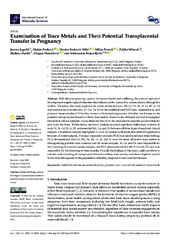Приказ основних података о документу
Examination of Trace Metals and Their Potential Transplacental Transfer in Pregnancy
| dc.creator | Jagodić, Jovana | |
| dc.creator | Pavlović, Slađan | |
| dc.creator | Borković Mitić, Slavica | |
| dc.creator | Perović, Milan | |
| dc.creator | Miković, Željko | |
| dc.creator | Đurđić, Slađana | |
| dc.creator | Manojlović, Dragan | |
| dc.creator | Stojsavljević, Aleksandar | |
| dc.date.accessioned | 2022-08-22T11:17:02Z | |
| dc.date.available | 2022-08-22T11:17:02Z | |
| dc.date.issued | 2022 | |
| dc.identifier.issn | 1422-0067 | |
| dc.identifier.uri | http://radar.ibiss.bg.ac.rs/handle/123456789/5020 | |
| dc.description.abstract | With the ever-growing concern for human health and wellbeing, the prenatal period of development requires special attention since fetuses can be exposed to various metals through the mother. Therefore, this study explored the status of selected toxic (Pb, Cd, Ni, As, Pt, Ce, Rb, Sr, U) and essential trace metals (Mn, Co, Cu, Zn, Se) in the umbilical cord (UC) sera, maternal sera, and placental tissue samples of 92 healthy women with normal pregnancies. A further aim focuses on the potential transplacental transfer of these trace metals. Based on the obtained levels of investigated elements in clinical samples, it was observed that all of the trace metals cross the placental barrier and reach the fetus. Furthermore, statistical analysis revealed significant differences in levels of toxic Ni, As, Cd, U, Sr, Rb, and essential Mn, Cu, and Zn between all three types of analyzed clinical samples. Correlation analysis highlighted As to be an element with levels that differed significantly between all tested samples. Principal component analysis (PCA) was used to enhance these findings. PCA demonstrated that Cd, Mn, Zn, Rb, Ce, U, and Sr were the most influential trace metals in distinguishing placenta from maternal and UC serum samples. As, Co, and Cu were responsible for the clustering of maternal serum samples, and PCA demonstrated that the Pt level in UC sera was responsible for the clustering of these samples. Overall, the findings of this study could contribute to a better understanding of transplacental transfer of these trace metals, and shed a light on overall levels of metal exposure in the population of healthy pregnant women and their fetuses. | sr |
| dc.language.iso | en | sr |
| dc.publisher | Basel: MDPI | sr |
| dc.relation | info:eu-repo/grantAgreement/MESTD/inst-2020/200007/RS// | sr |
| dc.relation | info:eu-repo/grantAgreement/MESTD/inst-2020/200288/RS// | sr |
| dc.rights | openAccess | sr |
| dc.rights.uri | https://creativecommons.org/licenses/by/4.0/ | |
| dc.source | International Journal of Molecular Sciences | sr |
| dc.subject | umbilical cord serum | sr |
| dc.subject | maternal serum | sr |
| dc.subject | placenta | sr |
| dc.subject | toxic trace metals | sr |
| dc.subject | essential trace metals | sr |
| dc.title | Examination of Trace Metals and Their Potential Transplacental Transfer in Pregnancy | sr |
| dc.type | article | sr |
| dc.rights.license | BY | sr |
| dc.rights.holder | © 2022 by the authors. Licensee MDPI, Basel, Switzerland | sr |
| dc.citation.issue | 15 | |
| dc.citation.volume | 23 | |
| dc.identifier.doi | 10.3390/ijms23158078 | |
| dc.identifier.pmid | 35897677 | |
| dc.identifier.scopus | 2-s2.0-85135383506 | |
| dc.identifier.wos | 00083903480000 | |
| dc.citation.apa | Jagodić, J., Pavlović, S., Borković-Mitić, S., Perović, M., Miković, Ž., Đurđić, S., et al. (2022). Examination of Trace Metals and Their Potential Transplacental Transfer in Pregnancy. International Journal of Molecular Sciences, 23(15), 8078. | |
| dc.citation.vancouver | Jagodić J, Pavlović S, Borković-Mitić S, Perović M, Miković Ž, Đurđić S, Manojlović D, Stojsavljević A. Examination of Trace Metals and Their Potential Transplacental Transfer in Pregnancy. Int J Mol Sci. 2022;23(15):8078. | |
| dc.citation.spage | 8078 | |
| dc.type.version | publishedVersion | sr |
| dc.identifier.fulltext | https://radar.ibiss.bg.ac.rs/bitstream/id/10780/bitstream_10780.pdf | |
| dc.citation.rank | M21 |

